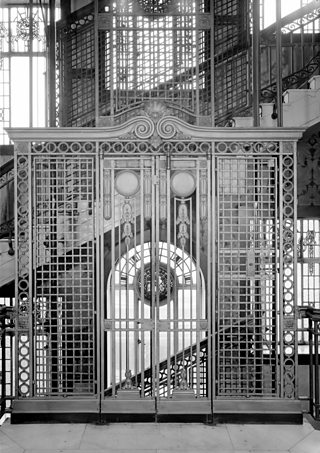Lift off! 10 incredible facts about the elevator
����ý Radio 4’s Lift Going Up – a new cultural history of the elevator – features a lift that comes to life. This chatty lift tells the story of how its invention changed the way we live, from enabling hotels to get bigger and grander, to transforming top floor flats from undesirable spaces to the glamorous penthouses we know today.
Here are 10 fascinating facts about lifts...
-
![]()
Listen to Lift Going Up
Emma Clarke plays the voice of the lift in this cultural history of the elevator.
1. Before the lift, the top floor was the worst place to live
Before the invention of the lift, the top floor wasn’t glamorous – far from it. “Before the elevator, the rooms directly under the roof are always poor and anxious and illegitimate spaces,” says Andreas Bernard, author of Lifted: The cultural History of the Elevator. In fact, the highest story was considered as unhealthy and as dangerous as the cellar. But the invention of the lift changed everything: all of a sudden, the most interesting and expensive spaces in a multi-story building were at the top. The penthouse was born! And the vertical hierarchy of buildings was changed forever.

2. The first buildings to feature elevators were hotels
The first buildings to feature passenger elevators were large, urban hotels – a new kind of building in major cities like New York, London and Paris. The first of these hotels to have a passenger elevator installed was the Fifth Avenue Hotel in New York, which opened in 1859, and was designed specifically to incorporate a lift. It was considered a luxury item that prevented guests from having to climb the stairs.
3. Lifts used to be called “rising rooms”
The Langham in central London, which opened in 1865, is thought of as Europe’s first grand hotel. It also claims to be the first London hotel to feature hydraulic lifts. At the time, however, these weren’t called lifts – they were instead referred to by the staff and clientele as “rising rooms.”
4. Early lifts had plush benches for passengers to sit on
The design of these early lifts was very specific says Dr Lee Gray, a specialist in the history of vertical transportation at the University of North Carolina: “Each car would have had a very nice upholstered bench. Many of them had beautiful woodwork, mirrors, a gaslighted chandelier hanging down from the centre of the car.” And they all had an operator who was in charge of opening and closing the door and sending the lift up or down very slowly. Speed of travel wasn’t an issue – the guests were there to be pampered!
5. One early handbook advised lift users on how to dress

“There was an awareness, in the early 20th century, that exiting an elevator is like stepping out into society – and therefore you had to look good,” says Dr Sean Williams of Sheffield University. Even the ding of the bell above the door had the effect of attracting the attention of passers-by! There was a whole range of handbooks, with one for men that tried to inculcate the appropriate dress and behaviour for entering the hotel lobby. “The lift settling onto the level of a lobby is like a curtain rising on a social stage,” says Sean.
6. In Germany, boys would study for three years to become an elevator operator
In the early days of the lift, the job of an elevator operator was considered highly skilful. Early elevators were all controlled by a device called a shipper rope. Operators had to stop pulling at the rope before the elevator came to the desired floor because even when they stopped, the cabin still moved. This was all done by experience: knowing when to pull the rope and stop the engine so that the car glided to a halt level with the landing. In pre-WWI Germany, if you wanted to be an elevator operator you were required to train for three years.
7. The push button meant the end of the lift boy
“The push button I would say is one of the most interesting inventions in modern life,” says Andreas. It came into existence in the early 20th century and was finally established in the 1920s in Europe. It handed control of the lift over to the passengers themselves and fundamentally ended the epoch of the very skilful elevator operator. After the First World War, the golden age of the lift and lift boy was over.
8. Your own private lift at The Langham will set you back around £24,000
If you book The Langham hotel’s luxury penthouse suite, you get your very own private lift – along with six bedrooms, 450 square meters of floor space, a baby grand piano, 24-hour butler service and access to a private chef. However, you’ll need plenty of sterling if you want to stay in the Sterling suite. The maximum price of this suite is around £24,000. Per night.

9. The lift in the world’s tallest building reaches heights of 500m
The tallest building in the world is the Burj Khalifa in Dubai. The lift that climbs to its 163rd story covers a distance of 504 metres – and it’s the highest that any lift can take a person. It’s not feasible for standard elevators to travel distances of more than 500m, as the weight of the steel ropes themselves become too great: there is a point where the cables weigh so much, their own weight will cause them to fail.
Standard elevators can't travel distances of more than 500m: there's a point where the cables weigh so much, their own weight will cause them to fail.
10. Lifts of the future may be able to travel horizontally
However, limitations on height – and even direction – may soon be a thing of the past. Thyssenkrupp Elevator in Germany have developed a prototype lift system that they call “MULTI”, because it can move in multiple directions. CEO Michael Cesarz explains how the ropeless lifts work through use of a magnetic field and artificial intelligence. “There is no limitation on heights,” says Michael Cesarz. “We can go one or two or three kilometres if we wish to, which is not possible with ropes.” A test version is already installed in a tower in Rottweil, and the first building to host this revolutionary lift should be ready by 2025.
More from Seriously...
-
![]()
Listen to Lift Going Up
Emma Clarke plays the voice of the lift in this cultural history of the elevator.
-
![]()
11 Niche jobs that actually exist
Bizarrely specific jobs that are somehow real.
-
![]()
Seven things you might not know about stripes
What makes the stripe such a powerful pattern?
-
![]()
Nine fascinating facts about the history of exhaustion
Are we really more exhausted today than we have ever been before?




